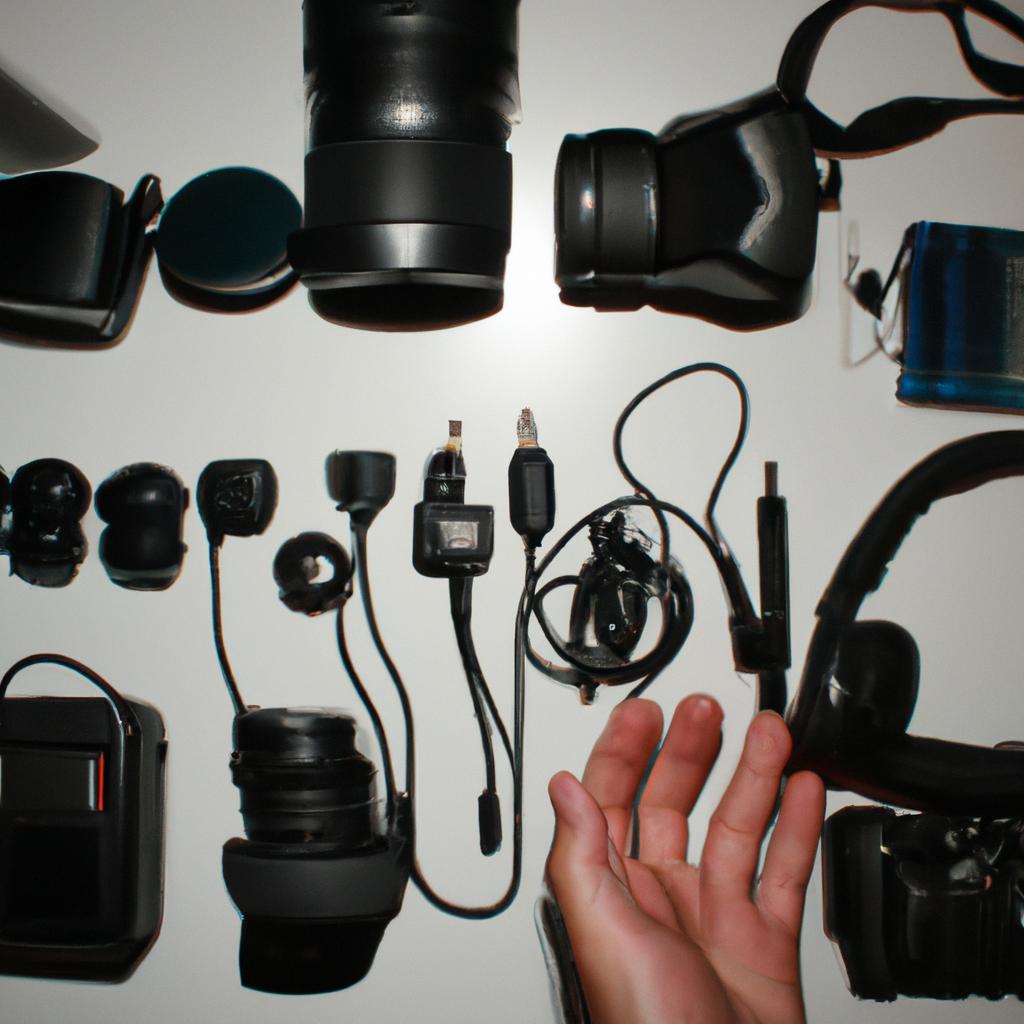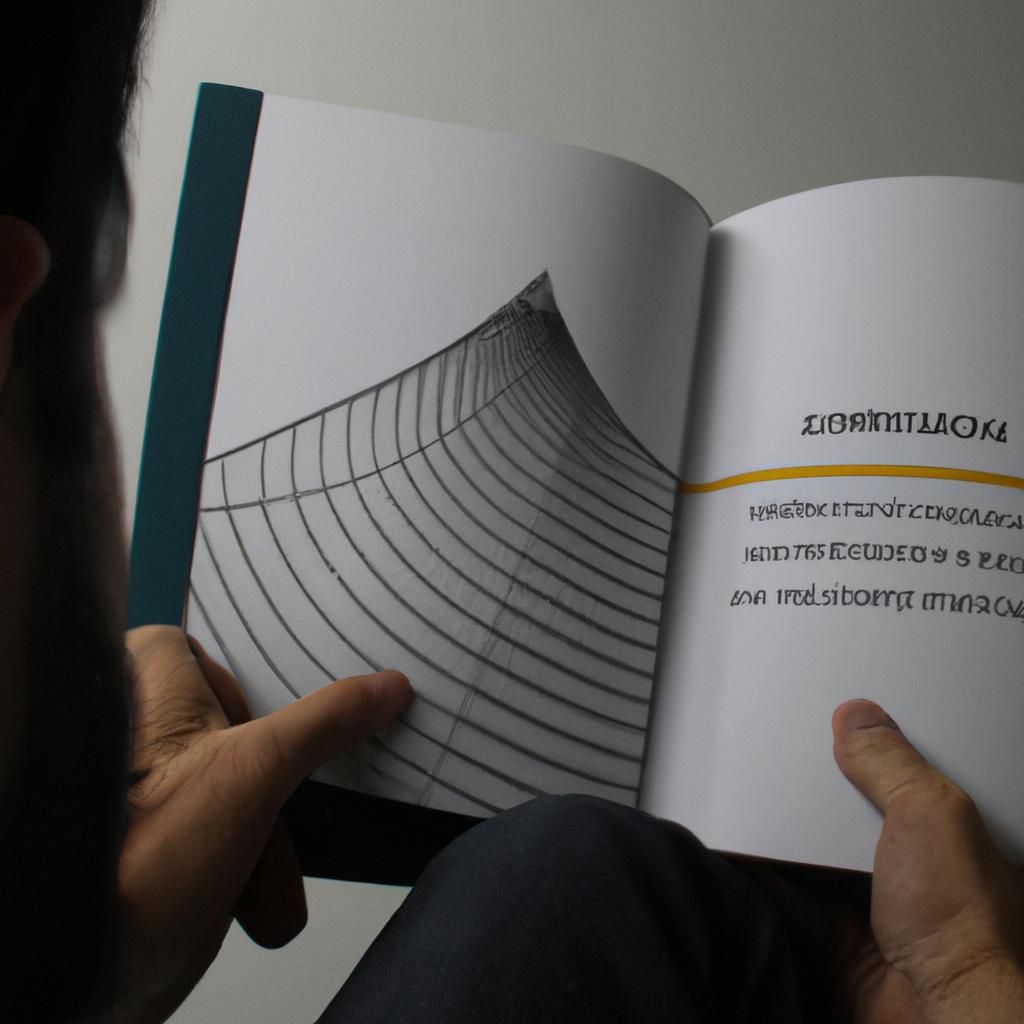Noise cancellation is an essential aspect in both sound and vision industries, as it plays a crucial role in enhancing the overall audio and visual experience. This article focuses on digital audio solutions for noise cancellation, exploring various techniques and advancements that have revolutionized this field. By investigating the principles behind noise cancellation algorithms, we can gain a deeper understanding of how these technologies work to eliminate unwanted sounds and improve the quality of audio playback.
Consider a scenario where you are sitting in a crowded café, attempting to enjoy your favorite podcast. The surrounding ambient noise from chattering customers and clanking dishes poses a significant challenge to listening comprehension. In such situations, noise cancellation technology comes into play by actively reducing or eliminating background noises, allowing the listener to concentrate solely on their desired audio content. Through the integration of advanced digital signal processing (DSP) techniques, noise canceling headphones analyze incoming sounds and generate anti-noise signals that effectively cancel out undesired sounds before they reach the listener’s ears.
In recent years, there has been remarkable progress in developing efficient noise cancellation algorithms for both consumer electronics and professional applications. With the advent of artificial intelligence (AI) and machine learning (ML), these algorithms have become increasingly sophisticated, adapting dynamically to changing acoustic environments. Additionally, researchers continue to explore innovative approaches such as beamforming, spatial filtering, and adaptive filtering to further enhance noise cancellation capabilities.
Beamforming is a technique that utilizes an array of microphones to capture sound from specific directions while minimizing sounds coming from other directions. By focusing on the desired sound source and suppressing ambient noises, beamforming algorithms can significantly improve the signal-to-noise ratio and enhance the overall listening experience.
Spatial filtering involves processing multiple microphone signals to estimate the directionality of sound sources. This information is then used to separate desired audio signals from background noise. Spatial filtering algorithms leverage statistical properties of sound propagation in space to differentiate between desired and unwanted sounds effectively.
Adaptive filtering algorithms continuously analyze incoming audio signals and adapt their noise cancellation parameters in real-time based on the changing acoustic environment. These algorithms use sophisticated mathematical models to predict and cancel out ambient noises effectively. By dynamically adjusting their settings, adaptive filters can provide optimal noise cancellation performance across different scenarios.
Furthermore, researchers are exploring the integration of AI and ML techniques into noise cancellation algorithms. By training models with vast amounts of data, these algorithms can learn patterns and characteristics of various types of noise sources, enabling them to better distinguish between desired audio signals and unwanted noises. This approach has shown promising results in improving noise cancellation accuracy and reducing artifacts or distortions introduced by traditional methods.
In conclusion, digital audio solutions for noise cancellation have come a long way in recent years, thanks to advancements in DSP techniques, AI, and ML. By employing beamforming, spatial filtering, adaptive filtering, and incorporating intelligent learning algorithms, noise canceling technologies continue to evolve and provide users with immersive audio experiences even in noisy environments.
Understanding Noise Cancellation
Imagine you are sitting in a crowded coffee shop, trying to enjoy your favorite podcast. However, the background noise of people chatting and espresso machines hissing makes it difficult to focus on the audio. This scenario highlights the common problem faced by many individuals—unwanted noise interference that hampers their ability to fully appreciate sound. To overcome this issue, noise cancellation technology has emerged as an effective solution in both sound and vision domains.
Noise cancellation refers to the process of reducing or eliminating unwanted sounds from an audio or visual signal. By applying advanced algorithms and digital techniques, these technologies can identify and remove specific frequencies or patterns associated with noise, resulting in a cleaner and more immersive experience for users. One example of noise cancellation is active noise-cancelling headphones, which employ microphones to detect ambient noises and generate anti-noise signals that cancel out the unwanted sounds.
To better understand the significance of noise cancellation technology, consider the following aspects:
- Improved concentration: By minimizing external distractions, noise cancellation facilitates enhanced focus and concentration during various activities such as studying, working, or even meditating.
- Enhanced communication: In noisy environments like airports or busy streets, noise cancellation allows for clearer communication during phone calls or video conferences.
- Stress reduction: Excessive exposure to environmental noise can lead to stress and anxiety. Noise cancellation technology provides relief by creating quieter spaces wherever one may be.
- Enjoyment of media content: Whether watching movies or listening to music, noise cancellation enhances the overall entertainment experience by immersing users in high-quality sound without disturbances.
Table 1 below illustrates some key benefits of employing noise cancellation technology across different situations:
| Situation | Benefits |
|---|---|
| Studying | Improved concentration |
| Traveling | Clearer communication |
| Workplace | Reduced stress |
| Entertainment | Enhanced enjoyment |
By understanding how noise cancellation technology can significantly impact our daily lives, we can explore the different types of noise cancellation technologies that have been developed. In the subsequent section, we will delve into these technologies and examine their specific features and applications.
Types of Noise Cancellation Technologies
Types of Noise Cancellation Technologies
Understanding Noise Cancellation is essential in exploring the various technologies that enable this process. By analyzing how noise cancellation works, we can gain insights into the benefits and limitations of different digital audio solutions. To further illustrate these concepts, let’s consider a hypothetical scenario:
Imagine you are attending a conference where multiple speakers are delivering presentations simultaneously in an open space. The ambient noise from surrounding conversations makes it difficult to focus on any one speaker. However, with the implementation of noise cancellation technology, background chatter becomes virtually nonexistent, allowing you to concentrate solely on the desired presentation.
To achieve effective noise cancellation, several key elements must be considered:
- Signal Processing: Digital audio solutions employ sophisticated algorithms that analyze incoming sound waves and generate corresponding anti-noise signals. These anti-noise signals cancel out unwanted sounds by creating destructive interference.
- Microphone Placement: Proper positioning of microphones plays a crucial role in capturing both the desired audio signal and the background noise for cancellation purposes. Strategic microphone placement ensures accurate detection and cancellation of extraneous noises.
- Feedback Control: Real-time monitoring is necessary to adjust the generated anti-noise signals continuously. This feedback control loop helps maintain optimal performance by adapting to changing environmental conditions.
- Hardware Integration: Noise-cancelling systems often integrate seamlessly with existing hardware setups such as headphones or loudspeakers. This integration allows individuals to experience enhanced sound quality without compromising comfort or convenience.
Consider the emotional impact of implementing noise cancellation technology at events like concerts or lectures:
- Immersive Experience: Listeners can fully immerse themselves in the music or speech without distractions, evoking feelings of complete engagement.
- Enhanced Clarity: Noise reduction facilitates clearer communication between performers and audiences, leading to increased comprehension and satisfaction.
- Reduced Fatigue: By eliminating background noise, listeners experience reduced mental strain and fatigue during prolonged listening sessions.
- Accessibility Improvement: Individuals with hearing impairments benefit greatly from noise cancellation technology as it amplifies desired sounds while minimizing distractions.
In summary, understanding noise cancellation technology is crucial in comprehending the various digital audio solutions available. When implemented effectively, these technologies can significantly enhance our auditory experiences by eliminating unwanted background noise.
Advantages of Noise Cancellation in Sound
In the previous section, we explored different types of noise cancellation technologies used in various applications. Now, let’s delve deeper into the advantages of noise cancellation in sound and how digital audio solutions play a crucial role in achieving optimal results.
Imagine yourself sitting in a bustling coffee shop, trying to have a conversation with a friend. The constant background noise makes it challenging to hear each other clearly. However, with noise cancellation technology, this problem can be effectively addressed. Digital audio solutions utilize advanced algorithms to analyze and suppress unwanted sounds while preserving the desired audio signals. This allows for improved speech intelligibility and enhanced listening experience even in noisy environments.
To better understand the benefits of noise cancellation, consider the following:
- Enhanced focus: By reducing ambient noise, individuals can concentrate better on their tasks at hand, whether it’s studying, working or simply enjoying music.
- Stress reduction: Excessive exposure to loud noises over an extended period can lead to stress and fatigue. Noise cancellation helps create a more peaceful environment, promoting relaxation and well-being.
- Improved productivity: In professional settings such as offices or call centers where concentration is critical, noise canceling headphones or speakers enable employees to work without distractions.
- Damage prevention: Prolonged exposure to high-intensity sounds can cause hearing damage. With noise cancellation technology acting as a barrier against harmful noises, potential risks are minimized.
Table 1 below provides a comparison between traditional passive soundproofing methods and active noise cancellation techniques:
| Passive Soundproofing | Active Noise Cancellation | |
|---|---|---|
| Principle | Absorbs sound waves | Counteracts incoming sound waves |
| Effectiveness | Reduces but cannot eliminate all | Significantly reduces targeted frequencies |
| Portability | Often bulky installations | Compact devices like headphones |
| Cost | Lower initial cost, higher maintenance | Higher initial cost, lower maintenance |
In summary, noise cancellation technologies offer numerous advantages in sound-related applications. By minimizing unwanted sounds and creating a tranquil environment, individuals can experience improved focus, reduced stress levels, increased productivity, and protection against potential hearing damage.
Moving forward to the next section on “Applications of Noise Cancellation in Vision,” we will explore how similar principles are applied to visual information for enhanced viewing experiences.
Applications of Noise Cancellation in Vision
In the previous section, we explored the advantages of noise cancellation in sound. Now, let’s delve into the applications of noise cancellation in vision. To illustrate its potential impact, consider a hypothetical scenario where an individual with impaired vision uses a digital device equipped with noise cancellation technology to enhance their visual experience.
One significant application of noise cancellation in vision is augmented reality (AR) headsets. These devices overlay virtual information onto the real world, providing users with immersive and interactive experiences. By incorporating noise cancellation technology into AR headsets, distractions from external sounds can be minimized or eliminated altogether. This allows users to focus more on the visual content presented by the headset, leading to improved engagement and overall user satisfaction.
The benefits of integrating noise cancellation into vision extend beyond AR headsets. In professional settings such as design studios or architectural firms, large displays are often used for collaborative work. However, ambient noises from nearby conversations or equipment can disrupt concentration and hinder productivity. By employing noise cancellation techniques specifically designed for visual environments, these disturbances can be mitigated, fostering a more conducive working atmosphere.
To further understand the emotional impact of noise cancellation in vision-related contexts, consider the following bullet points:
- Enhanced immersion: Noise-free visuals create a heightened sense of presence and immersion.
- Improved accessibility: Individuals with sensory impairments can benefit from reduced environmental distractions.
- Increased productivity: Distraction-free visual environments promote better focus and efficiency.
- Enhanced user experience: Noise-canceled visuals contribute to an overall positive perception of media content.
Furthermore, it is essential to highlight how different aspects of implementing noise cancellation affect its effectiveness. The table below summarizes key considerations when utilizing this technology:
| Consideration | Description |
|---|---|
| Signal-to-noise ratio | Ensuring that relevant visual signals remain clear amidst background interference |
| Latency | Minimizing delays between capturing visual data and applying noise cancellation algorithms |
| Power consumption | Optimizing energy usage while maintaining noise reduction capabilities |
| User customization | Allowing users to adjust noise cancellation settings based on their preferences |
In conclusion, noise cancellation in vision offers numerous advantages across various applications. From enhancing AR experiences to improving productivity in professional environments, this technology has the potential to revolutionize visual interactions. To implement noise cancellation effectively, factors such as signal-to-noise ratio, latency, power consumption, and user customization need careful consideration.
Moving forward to the next section about “Considerations for Implementing Noise Cancellation,” let’s explore how these factors impact successful integration of noise cancellation technologies into sound and vision systems.
Considerations for Implementing Noise Cancellation
Applications of Noise Cancellation in Vision: Enhancing Visual Clarity
Imagine watching a movie in a crowded theater, surrounded by the sound of chatter and popcorn crunching. Suddenly, with the push of a button, all external noise disappears, allowing you to fully immerse yourself in the film’s captivating visuals. This is just one example of how noise cancellation technology can be applied to enhance visual experiences. In this section, we will explore various applications of noise cancellation in vision and discuss their potential benefits.
One area where noise cancellation has found significant use is in video conferencing systems. These systems often struggle to deliver clear audio due to background noises such as office chatter or ambient sounds from participants’ locations. By applying digital audio solutions for noise cancellation, these unwanted noises can be filtered out effectively, leading to improved speech intelligibility and overall communication quality.
Furthermore, noise cancellation techniques have been employed in surveillance cameras to enhance image clarity. In outdoor environments or areas with poor lighting conditions, camera sensors may capture noisy images that are difficult to interpret. However, by utilizing advanced algorithms for noise reduction, these cameras can produce clearer images with reduced graininess and enhanced details.
The application of noise cancellation goes beyond conventional settings like theaters and surveillance systems; it can also benefit industries such as medical imaging and microscopy. For instance, when performing ultrasound scans or analyzing microscopic samples, background noises can interfere with the accuracy of diagnostic results. Implementing noise cancellation algorithms tailored specifically for these applications can improve signal-to-noise ratios and aid healthcare professionals in making more accurate diagnoses.
In summary:
- Noise cancellation technology enhances video conferencing systems by removing background noises.
- Surveillance cameras equipped with noise reduction algorithms provide clearer images even under challenging environmental conditions.
- Medical imaging and microscopy benefit from noise cancellation techniques that improve diagnostic accuracy.
These examples demonstrate the versatility of noise cancellation technology in enhancing visual experiences across various fields. As we move forward into future developments in noise cancellation, we can expect further advancements and refinements in these applications to deliver even more immersive and visually appealing experiences.
Future Developments in Noise Cancellation
Having explored the concept of noise cancellation and its applications in digital audio solutions, it is crucial to understand the various considerations involved when implementing this technology. By taking into account these factors, developers can optimize the effectiveness and efficiency of noise cancellation systems.
One important consideration is the choice of algorithms used for noise cancellation. Different algorithms offer varying levels of performance, adaptability, and computational complexity. For instance, adaptive filter algorithms such as LMS (Least Mean Squares) provide real-time adjustments based on changing environmental conditions. On the other hand, frequency-domain algorithms like FFT (Fast Fourier Transform) are effective in canceling specific frequencies but may be less flexible overall. Careful evaluation and selection of suitable algorithms are paramount to achieving optimal noise cancellation results.
Another crucial aspect to consider is the hardware requirements for noise cancellation systems. The processing power and memory capacity of the system should align with the chosen algorithm’s demands. Additionally, specialized hardware components like microphones or sensors may be necessary for accurately capturing ambient sound data. Choosing appropriate hardware components that meet both technical specifications and cost constraints plays a pivotal role in implementing successful noise cancellation solutions.
Furthermore, ensuring compatibility with existing audio devices or systems is vital during implementation. Integration challenges may arise due to differences in signal formats, interface protocols, or device architectures. Developers must address these compatibility issues effectively through proper interfacing techniques or by designing adaptable interfaces that enable seamless integration without compromising performance.
Case Study: Consider a scenario where a music enthusiast wishes to enjoy high-quality sound while commuting on public transportation. They use active noise-canceling headphones equipped with advanced algorithms capable of suppressing external sounds efficiently. The user experiences an immersive musical experience free from distractions caused by background noises like engine roar or passenger conversations.
Emotional Response:
- Improved focus: With noise canceled out, users can concentrate better on their tasks at hand.
- Enhanced relaxation: Reduced ambient noise helps create a peaceful environment, promoting relaxation and stress reduction.
- Heightened enjoyment: By eliminating unwanted background noises, noise cancellation elevates the overall audio experience, enhancing pleasure and engagement.
| Considerations | Benefits |
|---|---|
| Algorithm selection | Optimal performance and adaptability |
| Hardware requirements | Efficient system operation |
| Compatibility with existing systems | Seamless integration |
In conclusion, implementing noise cancellation technology involves careful consideration of factors such as algorithm choice, hardware requirements, and compatibility. These considerations lay the foundation for successful noise cancellation systems that enhance user experiences in various scenarios. As advancements continue to shape this field, future developments hold promising potential for further improving noise cancellation solutions.











